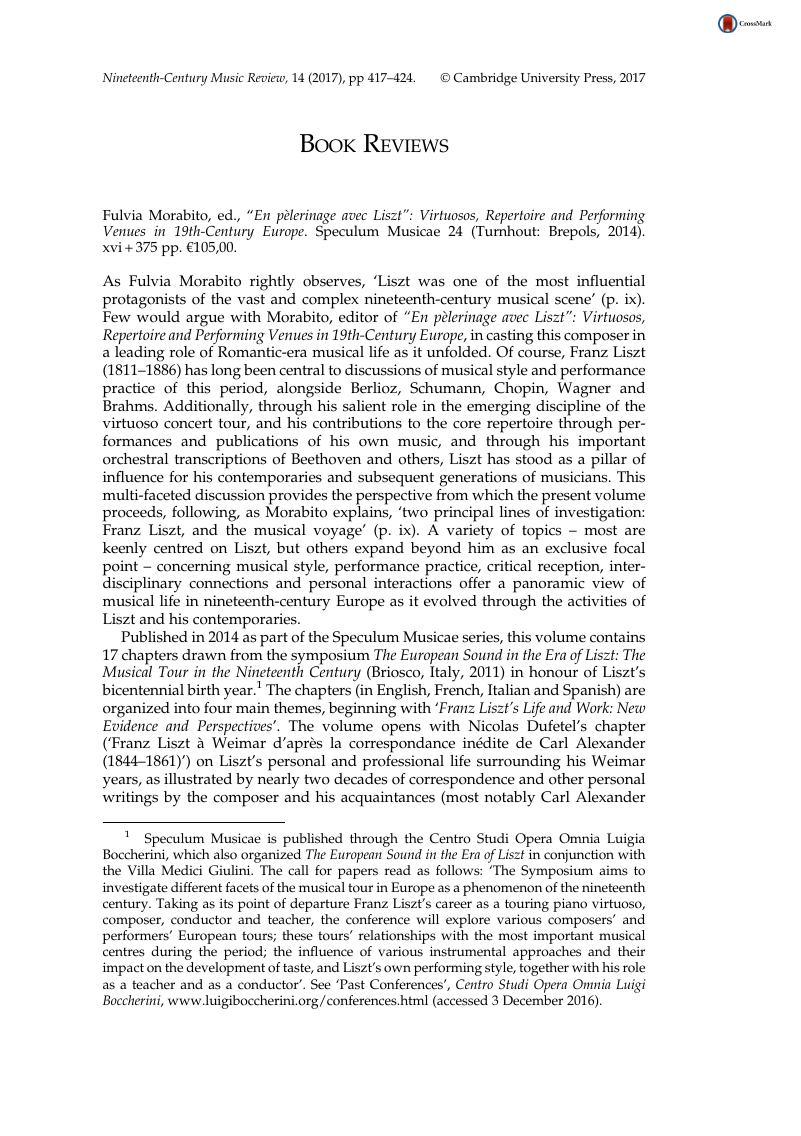No CrossRef data available.
Article contents
Fulvia Morabito, ed., “En pèlerinage avec Liszt”: Virtuosos, Repertoire and Performing Venues in 19th-Century Europe. Speculum Musicae 24 (Turnhout: Brepols, 2014). xvi+375 pp. €105,00.
Review products
Published online by Cambridge University Press: 17 April 2017
Abstract

- Type
- Book Reviews
- Information
- Nineteenth-Century Music Review , Volume 14 , Special Issue 3: Music in Nineteenth-Century Romania , December 2017 , pp. 417 - 421
- Copyright
- © Cambridge University Press 2017
References
1 Speculum Musicae is published through the Centro Studi Opera Omnia Luigia Boccherini, which also organized The European Sound in the Era of Liszt in conjunction with the Villa Medici Giulini. The call for papers read as follows: ‘The Symposium aims to investigate different facets of the musical tour in Europe as a phenomenon of the nineteenth century. Taking as its point of departure Franz Liszt’s career as a touring piano virtuoso, composer, conductor and teacher, the conference will explore various composers’ and performers’ European tours; these tours’ relationships with the most important musical centres during the period; the influence of various instrumental approaches and their impact on the development of taste, and Liszt’s own performing style, together with his role as a teacher and as a conductor’. See ‘Past Conferences’, Centro Studi Opera Omnia Luigi Boccherini, www.luigiboccherini.org/conferences.html (accessed 3 December 2016).
2 Examples include an excerpt from Liszt’s La romanesca, and his setting of Victor Hugo’s ‘Gastibelza’. See Myers, ‘What is “Spanish” about Liszt?’, p. 128 and p. 130, respectively.
3 Alan Walker discusses Liszt’s taking of the lower orders in the Catholic Church in the 1860s, and his personal connection to the oratorio Christus in the following decade. See Alan Walker, et al. ‘Liszt, Franz’, Grove Music Online. Oxford Music Online. Oxford University Press, www.grovemusic.com (accessed 4 December 2016).
4 The complete programme for the symposium The European Sound in the Era of Liszt can be viewed online at www.luigiboccherini.org/images/europeansound-low.pdf (accessed 4 December 2016).
5 Two excellent general resources for Liszt studies include Saffle, Michael, Franz Liszt: A Research and Information Guide, 3rd ed. (New York: Routledge, 2013)Google Scholar, and Hamilton, Kenneth, ed., Cambridge Companion to Liszt (Cambridge: Cambridge University Press, 2005)CrossRefGoogle Scholar. Both volumes contain chapters on Liszt’s vocal music, as do various broader surveys of choral music, art song and stage works.
6 Morabito refers to Schnapper’s chapter as the ‘last, lengthy article’ in ‘The Musical Journey’, but then follows with a short overview of Sichowiejko’s contribution, prior to addressing the final section.



